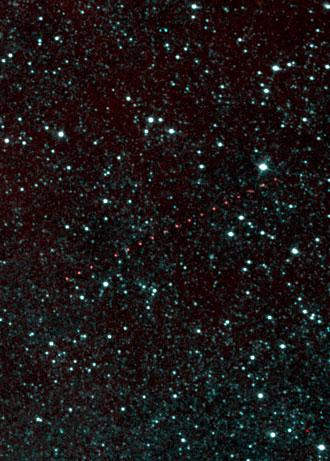
A color composite image showing multiple detections of the main belt asteroid (872) Holda. The images combined to make this composite were obtained on the first day of the NEOWISE Reactivation survey.
Credit: NEOWISE/NASA/JPL
The NEOWISE project was the asteroid-hunting portion of the Wide-field Infrared Survey Explorer (WISE) mission. Funded by NASA's Planetary Science Division, NEOWISE harvested measurements of asteroids and comets from the WISE images and provided a rich archive for searching WISE data for solar system objects.
WISE was launched in December 2009, and surveyed the full sky in four infrared wavelength bands (3.4, 4.6, 12 and 22 μm) until the frozen hydrogen cooling the telescope was depleted in September 2010. The survey continued as NEOWISE for an additional four months using the two shortest wavelength detectors. The spacecraft was placed into hibernation in February 2011, after completing its search of the inner solar system.
During its primary mission, NEOWISE delivered infrared detections of more than 158,000 minor planets to the scientific community, including more than 34,000 new discoveries. NEOWISE data have been used to set limits on the numbers, orbits, sizes, and probable compositions of asteroids throughout our solar system, and enabled the discovery of the first known Earth Trojan asteroid.
NEOWISE had been brought out of hibernation to learn more about the population of near-Earth objects and comets that could pose an impact hazard to the Earth. During its multiyear survey in the 3.4 and 4.6 μm infrared bands, NEOWISE rapidly characterized near-Earth objects (NEOs) and obtained accurate measurements of their diameters and albedos (how much light an object reflects). NEOWISE was equally sensitive to both light-colored asteroids and the optically dark objects that are difficult for ground-based observers to discover and characterize.
NEOWISE observations resumed in December 2013. Just six days after the survey start, NEOWISE discovered its first potentially hazardous near-Earth asteroid, 2013 YP139.
The characteristics of and initial performance of the NEOWISE Reactivation mission are described in Mainzer et al. 2014, ApJ, 792, 30.
The Single-exposure image and extracted source information from each year of NEOWISE observations were released on:
Diameters and albedos for asteroids detected by NEOWISE during the first seven years have been published by:
NEOWISE survey observations were completed on July 31, 2024. The spacecraft was decommissioned on August 8, 2024 and re-entered the Earth's atmosphere on November 1, 2024.
During its 10.6 years of operations, NEOWISE observed the sky 21.3 complete times. Nearly 1.6 million infrared measurements were made of over 44,000 different solar system objects including 1598 NEOs and 291 comets.
The NEOWISE project delivered a catalog of asteroid physical properties to NASA’s Planetary Data System (https://sbn.psi.edu/pds/resource/neowisediam.html) based on fits to the measurements from preliminary data processing. The project reprocessed all primary mission solar system data to extend the search for asteroids and comets to fainter limits, and to take advantage of the improved photometric and astrometric calibrations available. These detections were submitted to the Minor Planet Center where they have been ingested and published. The physical property catalog will be updated following the end of the NEOWISE mission to include the fits of all objects detected by the survey, as well as the improved fits to the reprocessed data, fits to objects found via manual pre-covery searches, and fits to objects detected in stacked observations.
The Principal Investigator for NEOWISE is Amy Mainzer of the University of California, Los Angeles. The Jet Propulsion Laboratory (JPL) manages NEOWISE for NASA's Science Mission Directorate, and carries out mission operations. The Space Dynamics Laboratory, Utah State University provided the science instrument. Ball Aerospace and Technologies Corp. built the spacecraft. Science operations, data processing and archiving take place at IPAC at the California Institute of Technology.
When acknowledging the NEOWISE project, please cite Mainzer et al. 2011 ApJ 731, 53.